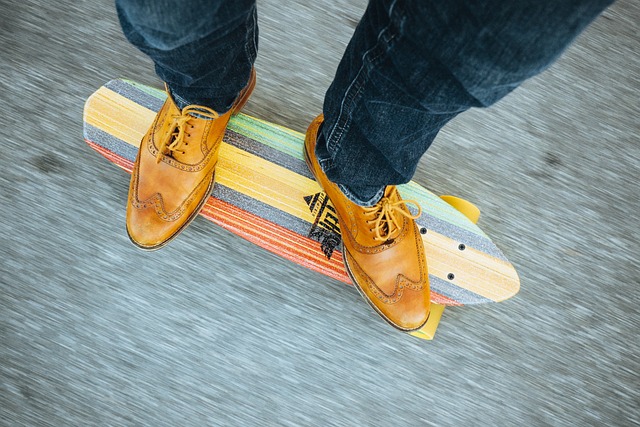Beginners in longboarding benefit from an extended deck length (90-100 cm) for enhanced stability and control. This design allows for longer turns, flowy maneuvers, and basic tricks, offering a smoother ride on various terrains like skateparks or coastal pathways. The extra length provides more foot placement options, aiding in learning turns, carving, and speed control. Choosing the right deck, wheels, and trucks focused on comfort and stability is crucial. Beginners should start with drop-through decks for ease of use, practicing basic techniques like pushing, carving, and turning until comfortable before advancing to more complex maneuvers.
Looking to enhance your longboarding experience as a beginner? Consider extending your deck length for improved stability and balance. This guide explores why longer decks are beneficial for newcomers, covers choosing the right size based on height, discusses deck types, recommends suitable wheels and trucks, offers essential tips, warns of common mistakes, and introduces advanced techniques. Elevate your skills with an extended longboard—dive in now!
What is an extended deck length?

An extended deck length refers to a longboard’s nose and tail areas being elongated beyond standard sizes. This design choice is popular among longboard for beginners who are looking to explore different riding styles and techniques. By increasing the deck’s overall length, riders gain access to more versatile options, such as carving longer turns, performing flowy maneuvers, and even attempting more advanced tricks like ollies and pop shuvits.
An extended deck length offers a smoother ride and enhanced stability, making it easier for newcomers to maintain balance while gaining confidence on the board. The added length also provides extra space for foot placement, allowing riders to experiment with various stances and positions to suit their riding style. This versatility is particularly beneficial in dynamic environments like skateparks or along coastal pathways, where a longboard’s abilities are put to the test.
Why consider a longer deck for beginners?

For beginners looking to take up longboarding, selecting a longer deck can offer several advantages. Longboards for beginners typically range from 90 to 100 centimeters in length, providing stability and balance that shorter decks might lack. This extended length allows for a more gradual learning curve by offering additional surface area for foot placement and better weight distribution.
Moreover, a longer deck provides a larger platform for carving and turning, which are fundamental skills in longboarding. The increased length helps beginners feel more confident as they practice these maneuvers, gradually building up their skill set and endurance. This stability is especially beneficial when navigating uneven terrain or learning to control speed, making the experience less daunting and more enjoyable from the outset.
Benefits: Improved stability and balance

One of the key benefits of an extended deck length on a longboard for beginners is the significant improvement in stability and balance. The longer deck provides a larger surface area to distribute your weight, making it easier to maintain control while carving or cruising down the street. This added stability is particularly beneficial for new riders who are still getting a feel for balancing on two wheels.
With an extended deck length, beginners can also adopt a more relaxed stance, which further aids in maintaining equilibrium. This improved balance not only makes the riding experience more enjoyable but also helps build confidence as you progress from beginner to intermediate levels. By providing a more stable platform, longer decks allow riders to focus on perfecting their technique and exploring different longboard maneuvers without feeling constantly unsteady.
Choosing the right extended deck size for your height

When selecting an extended deck for a longboard for beginners, choosing the appropriate size based on your height is key. As a general guideline, stand with your feet shoulder-width apart and measure from the top of your head to the floor. This measurement will give you a good estimate of the minimum recommended deck length. For instance, if you’re around 5’6″ (1.68m) tall, a 32-inch (81cm) deck might be suitable.
Keep in mind that personal preference also plays a role. Some riders prefer longer decks for stability and carving, while others opt for shorter decks for more agile maneuvers. Consider your riding style and the type of longboarding you enjoy most—cruising, dancing, or carving—to make an informed decision about the extended deck size that best suits your height and riding preferences.
Deck types: Drop-through vs. Top mount

When choosing a longboard for beginners, one key consideration is the deck length. But before delving into extended deck lengths, understanding the fundamental types of decks—drop-through and top mount—is crucial.
Drop-through decks are characterized by a lower profile where the trucks sit closer to the center of gravity, offering stability and making them ideal for beginners learning to carve and turn. This design also facilitates easier pushing and makes it less likely to catch an edge during turns. Top mount decks, on the other hand, provide more flexibility in stance adjustment and allow for a wider range of tricks, but they require a higher level of skill to master. For a longboard for beginners, drop-through decks are often recommended due to their user-friendly design that promotes balance and control.
Selecting suitable wheels and trucks for beginner longboarders

When selecting wheels and trucks for a longboard suitable for beginners, prioritize comfort and stability. Larger wheels (around 70-85mm) are recommended as they provide smoother rides and better absorption of bumps, ideal for new riders navigating various terrains. Soft durometers (65-75) offer extra give, making them more forgiving on cracks and uneven surfaces. As for trucks, standard double-socket trucks from reputable brands designed for cruising or beginner longboarding are a safe bet. These trucks provide good turn response while maintaining stability at speed, crucial elements for building confidence as a beginner longboarder.
Essential tips for beginners with an extended deck

When starting with an extended deck, or a longboard for beginners, there are some key tips to keep in mind.
First, focus on building a strong foundation: learn the basic techniques like pushing, carving, and turning. These skills will be crucial as you progress. Start on smoother surfaces and take your time to get comfortable with the board’s longer wheelbase which affects handling compared to shorter decks. Practice regularly, focusing on balance and control; these are paramount when navigating longer distances or performing more advanced tricks.
Common mistakes to avoid on a longer board

When riding a longboard for beginners, especially with an extended deck length, it’s crucial to be aware of certain common mistakes to avoid. One of the main pitfalls is over-extending your reach while standing. Longer boards require a longer stride to maintain balance, so take your time to adjust and find the right stance that feels comfortable and secure.
Another mistake to steer clear of is leaning too heavily on the tail for support. While it might be tempting to rest on the back section when cruising, this can disrupt your board’s balance and make it harder to control. Instead, focus on engaging your core muscles and distributing your weight evenly across the deck to maintain stability and maneuverability.
Advanced techniques to unlock with practice

Advanced techniques can greatly enhance your longboard experience once you’ve mastered the basics. One powerful method is carving, which involves smoothly bending the board to create turns with minimal effort. Practice making small, controlled movements with your feet to initiate these curves. Speed control is another skill to master; learn how to gradually increase and decrease speed for more precise and flowing rides.
Don’t forget to experiment with different stances and foot placements. Finding the right stance that feels comfortable and allows you to distribute your weight effectively will dramatically improve your balance and stability, enabling you to tackle turns, drops, and obstacles with confidence.
